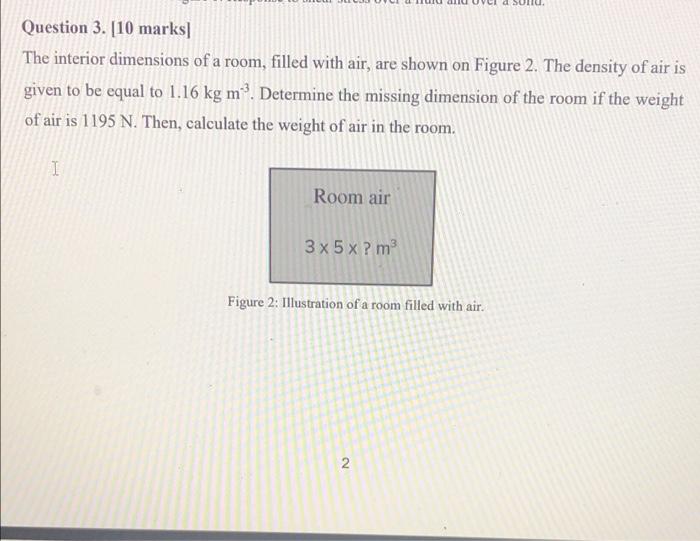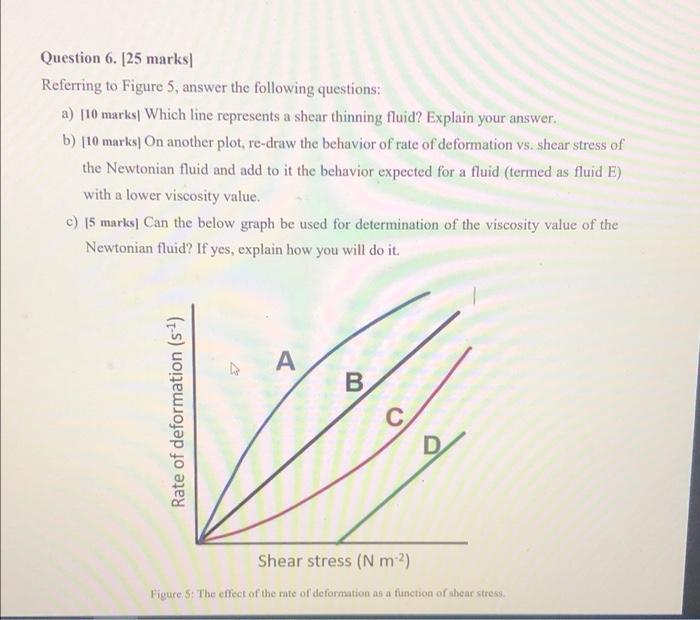Add text V Draw Question 1. [10 marks) Define the following fluid-related properties: (i) shear strain, (ii) viscosity, (iii) drag force and, (iv) specific gravity. [2.5 marks/definition] Question 2. [20 marks] Figure 1 displays the response to shear stress over a solid and over a fluid. a) (7.5 marks/explanation] Explain the difference between the behaviors illustrated on Figure 1 and indicate which behavior (illustrated on Figure 1A or 1B) corresponds to the response of a solid b) (5 marks) What is the significance of "B" on both Figures 1A and B. If shear stress has been removed, what happens to "B" for the case of a liquid (Figure 1A)? A B B'=P F F B B> B F F Figure 1: Response to shear stress over a fluid and over a solid. Question 3. [10 marks) The interior dimensions of a room, filled with air, are shown on Figure 2. The density of air is given to be equal to 1.16 kg m-'. Determine the missing dimension of the room if the weight of air is 1195 N. Then, calculate the weight of air in the room. I Room air 3x5x? m Figure 2: Illustration of a room filled with air. 2 a Question 4. [20 marks] A balloon is filled with H2 gas (Figure 3). At the specified conditions, He behaves as an ideal gas. Take the molecular weight of He to be 2.006 kg kmol" and consider that the balloon is sphere. Determine: a) [10 marksi The number of moles of H2 in the balloon. b) [10 marks] The mass of H, in that balloon and its specific volume. HE D = 9 m 25 C 250 kPa Figure 3: Illustration of a balloon filled with Hy gas. Omestion 5.115 marks! Question 5. [15 marks The torque and the rpm of a double cylinder viscometer (Figure 4) are given to be 0.9 Nm and 400 rpm, respectively. It is worth mentioning that the inner cylinder is completely submerged in gasoline (Newtonian fluid) and the viscous effects on the two ends of the inner cylinder are negligible. The length of the two cylinders is equal to 95 cm and the outer diameter of the inner cylinder is 9.5 cm a) (10 marks] Determine the viscosity of the fluid. b) 15 marks] Draw the behavior of the viscosity of this liquid (ga e) as a function of temperature 11 mm fluid Figure 4: Illustration of a double cylinder viscometer. Question 6. [25 marks] Referring to Figure 5, answer the following questions: a) [10 marks] Which line represents a shear thinning fluid? Explain your answer. b) [10 marks) On another plot, re-draw the behavior of rate of deformation vs. shear stress of the Newtonian fluid and add to it the behavior expected for a fluid (termed as fluid E) with a lower viscosity value. c) 15 marks] Can the below graph be used for determination of the viscosity value of the Newtonian fluid? If yes, explain how you will do it. A B Rate of deformation (s:-) . D Shear stress (N m2) Figure 5: The effect of the rate of deformation as a function or shear stress











